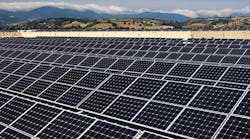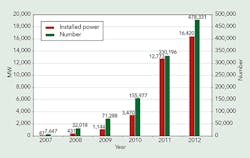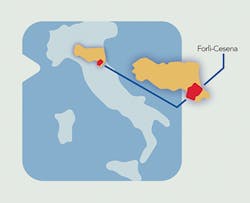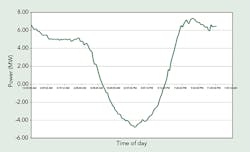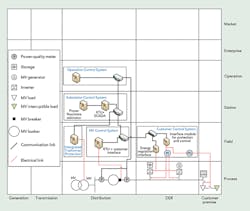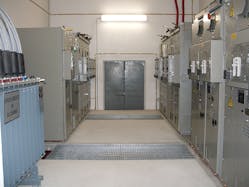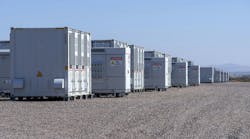GRID4EU is a four-year smart grid project cofunded by the European Commission. It was proposed by six distribution system operators (DSOs) — from the Czech Republic, Italy, France, Spain, Germany and Sweden — working in partnership with energy retailers, manufacturers and research organizations. The project’s main objectives are to maximize the integration of small- and medium-sized distributed renewable energy sources (RESs); increase energy efficiency; enable and integrate active demand; and develop new electric energy applications.
Each DSO involved with GRID4EU is responsible for a demonstration project with specific and clearly defined objectives linked to the main issues. The challenge assigned to the Italian DSO, Enel Distribuzione, is to develop an advanced control system to increase the medium-voltage (MV) hosting capacity of RESs, a project now being planned for the Forlì-Cesena province of the Emilia-Romagna region.
One of the main barriers of further increasing distributed generation at the international level is the hosting capacity of the existing MV network. The network was designed for mono-directional power flows, so the capacity to integrate distributed generators (DGs) is limited. Connecting a large number of DGs can create problems such as an unacceptable level of power quality, generation load imbalances, protection problems and overloads on the MV network. To maintain the necessary level of availability and power quality, the management of distribution networks in the presence of distributed and variable generation requires the development of new advanced network operation and energy management capabilities.
The evolution of photovoltaic plants in Italy. Courtesy of Gestore Servizi Energetici, www.gse.it.
Renewable Energy Facilities
During the past few years, a huge number of RES generators have been connected to the MV networks in Italy. A very impressive and significant result was achieved in 2011 when Italy registered the greatest increase of photovoltaic (PV) installed capacity in the world (10 GW, or 32% of the overall total), thereby achieving the second-largest PV installed capacity in the world.
This impressive increase in RES is the main driver of the Italian GRID4EU demonstration project being led by Enel Distribuzione and developed in partnership with Cisco, RSE, Selta and Siemens. The main goal is to demonstrate, in real-time operating conditions and on a large scale, how active control and demand response of distributed energy resources (DERs) — including generators, controllable loads and storage — can increase the MV network hosting capacity of DGs, enabling the distribution network to become more flexible.
Currently with field installations ongoing, the project aims to achieve an advanced control system communicating with MV DERs, high-/medium-voltage (HV/MV) substations, medium-/low-voltage (MV/LV) substations and a storage facility through an always-on Internet protocol standard-based communications system for real-time data exchange, using both wireless and wired technologies in accordance with IEC 61850.
The new system will allow for an increase in the MV network hosting capacity through the following ways:
• Implementing voltage control (at all nodes) and power flow control in the MV network
• Enabling ancillary services for MV network operation
• Developing new procedures for managing efficiently and reliably the disconnection of generation units in the event of unwanted islanding
• Enabling the dispatching of renewable generation on the MV network, including the use of a storage facility.
The key factor of the project is the direct involvement of DGs, which will become active actors in network management and operation, participating in voltage regulation through reactive power modulation.
It also includes the installation of an energy storage system (1 MVA and 1 MWh) whose active and reactive power modulation capabilities will be exploited to optimize network operation, in particular in relation to voltage regulation.
The Enel GRID4EU project is located in the province of Forlì-Cesena in the Emilia-Romagna region of Italy.
The Demonstration Project
Forlì-Cesena, where the demonstration project is located, is an area with a high penetration of RESs, the majority being PV — in total, some 105 MW — with 24 MV installations producing more than 500 kW in a geographical area with relatively low energy consumption. In particular, the demonstration section of the electricity network comprises two HV/MV substations supplying more than 20 MV lines. At least five MV DGs will be directly involved in the experimentation as they will actively participate in voltage regulation through reactive power modulation. This project also will impact about 35,000 LV customers who will benefit from the experimentation, even though they will not be involved directly.
The two selected HV/MV substations take into account the critical aspects related to the high penetration of DGs. For example, on Aug. 19, 2012, one of these substations was subject to reverse power flow (MV to HV) because of MV generation exceeding load. This phenomenon has been observed several times over the past few months, providing a clear indicator of the impact of high DG penetration.
Medium-/high-voltage backfeeding phenomena recorded Aug. 19, 2012.
Control System Architecture
The architecture of the control system is composed of five main functional blocks linked by the communications system:
• The operation control system (OCS)
• Substation control system (HV/MV substations)
• Integrated transformer protection (HV/MV transformer)
• MV control system
• Customer control system (MV generators and controllable loads).
The communications infrastructure is the backbone enabling all of the smart grid’s new functionalities. The architecture is based on an information communications technology infrastructure, allowing a real-time exchange (net of the intrinsic delays of the system) of information between all the relevant nodes on the electric network and the OCS/SCS. Different communications technologies will be tested using public infrastructure — a wide area network — through fixed network (xDSL), wireless technologies (LTE) and a power line carrier.
The overall system architecture, mapped on SGAM component layer.
The Control System
Enel Distribuzione manages the MV grid by means of control centers equipped with a supervisory control and data acquisition system (SCADA) and a distribution management system (DMS) that performs computations. The OCS is properly identified with the SCADA located in the control centres in charge of managing the MV grid, called Sistema di Telecontrollo rete MT. It communicates with the substation control system (SCS) located in the HV/MV substation, and it sends and receives information to and from the devices located in the HV/MV and MV/LV substations.
Located in the HV/MV substation, the SCS comprises the following subsystems and is the computational core of the entire control system:
- Remote terminal unit (TPT 2020)
- Local SCADA
- Substation computer, running algorithms for power flow management and DER control (voltage regulation, reactive and active power flows control, and anti-islanding procedures) as well as storage device dispatching.
- Communication network devices (router and switch).
The integrated transformer protection panel integrates the protection relays of the HV/MV transformer and the on-load tap changer managing system. It is in fact designed to manage the tap changers to implement the new voltage regulation logics and the new functionalities for DER management. The integrated transformer protection panel represents the interface system between the SCS and transformer control actuators managing tap changers on the basis of setting signals received by the SCS.
The MV control system performs the control of the MV network in coordination with the SCS and OCS. This system is comprised of the following equipment installed in MV/LV substations:
- Remote terminal unit
- Customer interface equipment
- Directional fault detector and measurements acquisition device
- Communication network device (router)
- Power line communication system.
The customer control system (CCS) is the interface system between the DSO control system and the MV customers, to implement reactive power control and enable active power regulation. The CCS receives input signals from the MV control system and sends output commands to the customer’s internal control system. The CCS is composed of three modules:
- Energy regulation interface
- Interface module for protection and control (DV7300)
- Communication network switch.
The core of the control system is the voltage regulation algorithm, whose main goal is to satisfy the technical constraints (voltage at nodes, current in branches, power exchange at the primary substation) in presence of very high DG penetration, minimizing the overall cost of the control actions needed.
To maintain all the technical parameters within desired ranges, the optimization algorithm relies on different system resources, both internal and external to the DSO:
- HV/MV substations’ on-load tap changer and capacitor banks operated by the DSO
- Reactive power injection and absorption by DGs
- Active and reactive power injection and absorption of an energy storage system
Furthermore, it will be possible to switch the energy storage system electrically over several MV feeders; the algorithm will provide suggestions about possible changes in the storage network connection point (opening and closing MV switches), according to the possible optimization results obtainable by connecting the energy storage system to one or another available feeder. These options will be evaluated and implemented by the operator in the control center.
Enel control centers are equipped with SCADA and distribution management systems.
The medium-voltage substation for the energy storage system includes new circuit breakers and remote terminal units.
Field Installation Status
The equipment prototype laboratory tests have been completed and field installation is ongoing along with the analysis of the first field test results. In addition to prototype development and laboratory testing, necessary field preparation activities took place in 2013 prior to equipment installation. An important milestone was the complete refurbishment of installing circuit breakers and new remote terminal units in the MV/LV substation for connection to the energy storage system, the installation of which was undertaken in June 2014.
In 2014, the focus has been on field installation and testing of all equipment, not only in the DSO’s premises but also the premises of the owners of the MV generators. The MV generators represent a key resource for network control and are currently being equipped with an interface for data and commands exchange with the control system.
The entire system is expected to be in operation by the end of 2014, which will be followed by a massive data acquisition campaign for key performance indicators. Therefore, the calculation, experimentation results and detailed analysis will be undertaken in 2015.
Jon Stromsather ([email protected]), head of the smart grids development unit of Enel Distribuzione S.p.A., has worked with smart grids technologies since 2002, when he joined the distribution system operator to work on its Telegestore project, the rollout of smart meters. Recently, Stromsather also has been heavily involved in the European cooperation on smart grids, in particular the development of the European Industrial Initiative on Electricity Grids and several smart grids projects.
Lilia Consiglio ([email protected]) joined Enel Distribuzione S.p.A. in 1992 and has been working in the field of remote control and distribution automation systems since 1996. Consiglio was involved in most of the technical activities to develop central systems and peripheral units for remote control of Enel’s HV/MV and MV/LV substations, and in the definition of algorithms for MV network automatic fault detection and restoration, presently adopted in Enel. She is now collaborating on several smart grids project at national and European levels.
Daniele Stein ([email protected]) graduated with a MSEE degree from the University of Pisa in 2006, also the year in which he started working at Enel’s Research Centre of Pisa. Today, he is a smart grids project manager for Enel Distribuzione S.p.A., where he has been working since 2007. From the beginning of his experience with Enel, Stein has worked in different network management areas, from network planning to operation and maintenance, and has gained experience on network automation and control. In the last four years, he has been deeply involved in the development of European and international projects.
Mentioned in this article:
ABB | www.abb.com
Alstom Grid | www.alstom.com
Armines | www.armines.net
Cez Distribuce | www.cezdistribuce.cz
Cisco | www.cisco.com
EDF | www.edf.com
eMeter | www.emeter.com
Enel Distribuzione S.p.A. | www.enel.com
ERDF | www.erdf.fr
European Commission | http://ec.europa.eu
GRID4EU | www.grid4eu.eu
Iberdrola | www.iberdrola.es
Itron | www.itron.com
KTH | www.kth.se
KU LEUVEN | www.kuleuven.be
Landis & Gyr | www.landisgyr.com
Ormazabal | www.ormazabal.com
RSE | www.rse-web.it
RWE | www.rwe.com
Schneider Electric | www.schneider-electric.com
Selta | www.selta.com
Siemens | www.siemens.com
TUD | www.tu-dortmund.de
UP Comillas | www.upcomillas.es
Vattenfall | http://corporate.vattenfall.com
ZIV | www.ziv.es
